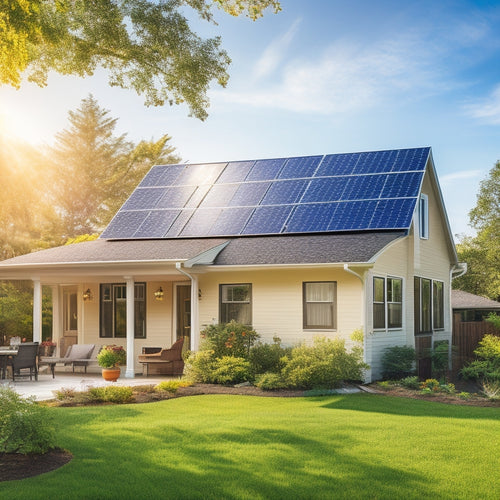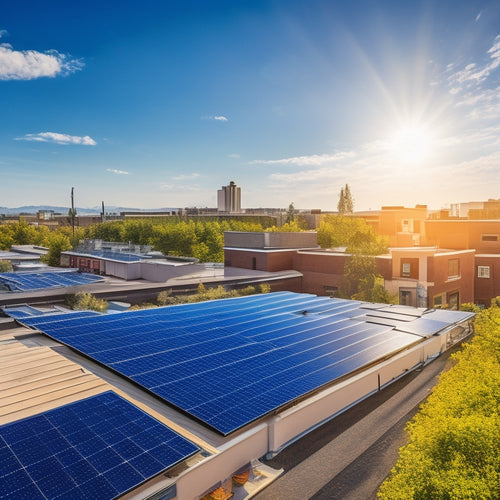
7 Essential Commercial Solar Panel Cleaning Schedules
Share
To minimize energy losses, you'll want to implement a thorough cleaning schedule for your commercial solar panels. Start with daily inspections and quick cleaning to remove loose debris, ensuring peak energy production. Weekly, focus on debris removal, considering patterns of accumulation and vegetation density. Bi-weekly, inspect panels for damage and debris. Monthly, deep clean panels to remove stubborn dirt. Quarterly, assess panel efficiency to identify potential losses. Semi-annually, refurbish panels, and annually, perform a detailed performance audit. By following these essential cleaning schedules, you'll guarantee peak energy output and minimize losses. Now, optimize your maintenance routine with specific guidance on each schedule.
Key Takeaways
• Daily inspections identify debris or dirt accumulation hindering energy output, allowing for prompt cleaning and energy production optimization.
• Understanding debris accumulation patterns and types helps create effective cleaning schedules, reducing energy production losses.
• Bi-weekly panel inspections focus on accessibility, clearing debris, and inspecting for damage or corrosion to maintain peak performance.
• Monthly deep cleaning sessions with soft-bristled brushes and mild detergent remove stubborn dirt, conserving water and improving efficiency.
• Quarterly panel efficiency checks assess energy production, comparing current output to expected levels, and inspecting panels for wear, damage, or debris.
Daily Inspection and Quick Cleaning
Perform daily inspections of your commercial solar panels to identify and address any debris or dirt accumulation that may be hindering their energy output.
During these inspections, pay attention to the Solar Brightness of your panels, as even slight obstructions can reduce their energy production. Check for signs of dirt, dust, or other contaminants that may be affecting Panel Reflectivity, which is critical for peak energy absorption.
Quickly remove any loose debris you find, as prompt cleaning can prevent more stubborn stains from forming.
Weekly Debris Removal Schedule
When creating your weekly debris removal schedule, understanding the patterns of debris accumulation on your commercial solar panels is crucial.
You'll want to identify the types of debris that tend to collect, such as leaves, dust, and bird droppings, and how frequently they need to be removed.
Debris Accumulation Patterns
When evaluating debris accumulation patterns on commercial solar panels, you'll typically find that loose debris like dust, dirt, and leaves tend to accumulate more rapidly on panels installed in areas with high foot traffic or surrounded by vegetation, necessitating a more frequent cleaning schedule. This is especially true during periods of extreme weather fluctuations, such as dust storms, which can accelerate debris accumulation.
To optimize your cleaning schedule, consider the following factors:
-
Proximity to high-traffic areas: Panels near walkways or roads may require more frequent cleaning.
-
Vegetation density: Panels surrounded by trees or shrubs may accumulate debris faster.
-
Weather patterns: Areas prone to dust storms or heavy rainfall may require more frequent cleaning.
Regular Maintenance Needs
To maintain peak energy output, you should implement a regular maintenance schedule that includes weekly debris removal to supplement your overall cleaning strategy. This routine check guarantees top performance and energy efficiency.
By incorporating system checks into your maintenance schedule, you can identify and address potential issues before they impact your energy output. Regular maintenance also provides cost benefits by reducing the need for more extensive repairs down the line.
Invest in staff training to make sure your team is equipped to perform these tasks efficiently. By tracking your system's performance, you can refine your maintenance schedule to maximize energy production.
Bi-Weekly Panel Inspection Routine
Perform a bi-weekly panel inspection to identify and address any potential issues before they have a major impact on energy production. This frequency allows you to stay on top of maintenance needs and guarantee your system operates at peak levels.
Here are three key aspects to focus on during your bi-weekly inspection:
-
Panel accessibility: Make sure all panels are easily accessible for cleaning and maintenance.
-
Debris removal: Clear any debris, such as leaves or twigs, that may be obstructing energy production.
-
Visual inspection: Visually inspect panels for signs of damage, cracks, or corrosion, and address any issues promptly.
Monthly Deep Cleaning Sessions
Schedule monthly deep cleaning sessions to remove stubborn dirt, grime, and other substances that can greatly reduce your solar panels' energy output. You'll be surprised at how much energy you can recover by doing so.
During these sessions, use a soft-bristled brush and a mild detergent to scrub away tough stains. Make sure to rinse your panels thoroughly to prevent water spots, which can lead to soil buildup and reduced energy output.
By doing so, you'll prevent soil buildup and conserve water in the long run. Remember, a clean panel is an efficient panel.
Quarterly Panel Efficiency Check
Every quarter, you should assess your solar panels' efficiency to identify potential issues and opportunities for improvement. This quarterly check is essential to maintaining peak energy production and reducing losses.
During this evaluation, you'll want to conduct energy audits to analyze your system's performance metrics. Here are key areas to focus on:
-
Energy output: Compare your system's current energy production to its expected output to identify any deviations.
-
Performance metrics: Review metrics such as temperature coefficients, fill factors, and irradiance to pinpoint potential issues.
-
System health: Inspect your panels for signs of wear, damage, or debris accumulation that may be hindering performance.
Semi-Annual Panel Refurbishment
As you implement your semi-annual panel refurbishment schedule, you'll want to prioritize a dirty panel inspection to identify areas that require attention.
This process allows you to pinpoint issues that could be hindering your system's performance, such as debris buildup or faulty connections.
Dirty Panel Inspection
During your semi-annual panel refurbishment, you'll visually inspect the solar panels for signs of dirt, debris, or streaks that can reduce energy output, taking note of any areas that require more thorough cleaning or maintenance.
Conduct a thorough visual analysis to identify any issues, and perform panel testing to assess energy output. This inspection is vital to identify potential problems before they impact your energy production.
Some key areas to focus on during your inspection include:
-
Dirt and debris accumulation: Check for dust, pollen, or other substances that may be obstructing energy absorption.
-
Streaks and water spots: Inspect for streaks or water spots that can reduce panel efficiency.
-
Cracks and damage: Identify any cracks or damage to the panels or frames that may require repair or replacement.
Scheduled Maintenance Reminders
To guarantee your commercial solar panel system operates at peak efficiency, schedule semi-annual refurbishments to coincide with your visual inspections. This will prevent dirt and debris buildup from impacting energy production.
Set reminders using apps or automated notifications to make certain you never miss a scheduled maintenance window. During these refurbishments, plan for scheduled downtime to avoid disrupting your operations.
Keep meticulous maintenance logs to track your efforts and confirm compliance with industry regulations. By staying on top of these scheduled reminders, you'll maintain a clean and efficient system, maximizing energy production and minimizing revenue loss.
Stay in control of your system's performance with a proactive approach to maintenance.
Annual Panel Performance Audit
You should conduct an annual panel performance audit to identify potential issues and optimize energy output by comparing actual performance data with predicted values. This audit helps you pinpoint areas of improvement, reducing energy losses and ensuring your solar panels operate at maximum efficiency.
To guarantee a thorough audit, consider the following key aspects:
-
Audit Frequency: Schedule annual audits to track performance trends and identify potential issues before they escalate.
-
Energy Losses: Identify and quantify energy losses due to soiling, shading, or system malfunctions to prioritize corrective actions.
-
Performance Metrics: Analyze key performance indicators, such as capacity factor, performance ratio, and energy yield, to benchmark your system's performance.
Frequently Asked Questions
Can I Use Tap Water for Cleaning Commercial Solar Panels?
'You might think tap water is a convenient option, but beware - it can leave behind mineral deposits that reduce panel efficiency. Instead, opt for deionized water to maintain peak Water Quality and prevent long-term damage.'
How Often Should I Clean Solar Panels in High-Dust Areas?
In high-dust areas, you'll need to clean your solar panels more frequently, ideally every 2-3 months, to mitigate dust accumulation, as weather patterns like frequent winds and dry spells exacerbate the issue.
Do I Need Special Equipment for Cleaning Solar Panels?
"Did you know 20% of energy loss is due to dirty panels? To clean yours effectively, you'll need the right gear. You'll require a low-pressure water system (less than 1000 PSI) and a soft-bristle brush or a specialized solar panel cleaning brush to avoid scratching the panels."
Can I Clean Solar Panels During Peak Sun Hours?
You should avoid cleaning solar panels during peak sun hours, as it can reduce peak efficiency; instead, opt for morning cleaning when the panels are cooler, ensuring a more effective and safe cleaning process.
Are There Any Eco-Friendly Solar Panel Cleaning Solutions?
Did you know that 80% of solar panel soiling losses can be prevented with regular cleaning? You'll be glad to know that eco-friendly solar panel cleaning solutions do exist, leveraging Green Chemistry and Bio-based Cleaners to minimize environmental impact.
Related Posts
-

How to Finance Home Solar Panels
Financing home solar panels offers several strategies to lighten your initial costs while maximizing long-term benefi...
-

Solar Power Backup Solutions During Outages
Solar power backup solutions guarantee you have reliable energy during outages, providing essential power when the gr...
-

Solar Energy Solutions for Small Businesses
Switching to solar energy can be a game changer for your small business. You'll enjoy significant cost savings on mon...


